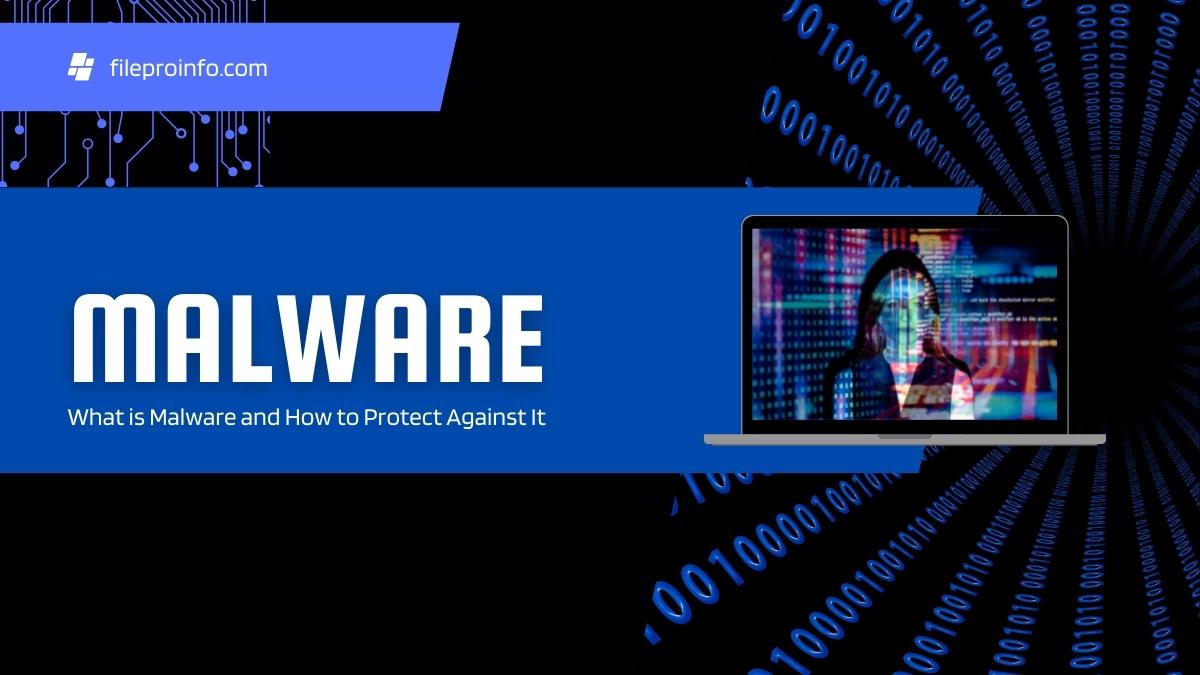
Malware is a type of malicious software that is designed to harm computer systems. It can be used to steal personal information, damage data, or even disable entire systems. Malware is often spread through email attachments or by visiting infected websites. Protecting your computer from malware requires using strong anti-malware software and keeping it up-to-date.
You should be familiar with this cybersecurity word. It’s a category under the header: “What is cybersecurity?”
Understanding Malicious Software
In computing, malicious software or malware is any software used to disrupt computer operations, gather sensitive information, or gain access to private computer systems. Malware is often disguised as legitimate software.
Malware includes viruses, spyware, and trojan horses. Viruses are self-replicating programs that infect a computer by attaching themselves to legitimate programs. Spyware is software that gathers sensitive information about a person or organization without their knowledge. Trojan horses are programs that appear to be benign but allow attackers to gain access to a system.
Malware can be spread in many ways, including email attachments, downloads from the Internet, and USB drives. Once a system is infected with malware, it can be difficult to remove. It is important to have malware protection on your computer and keep it up-to-date.
Here are 5 facts about how sneaky malware can be. And some good answers if you’re asking, “What is a Malware Attack?”
Malware Attacks Have Numbers
In 2020, there were 5.6 billion harmful programs active all around the world.
Personal Computer Users Are Worried
Americans are concerned that an infected machine could compromise their online networks and personal information. Over 70%, according to a study, belong to this category.
Email Is The Biggest Offender
Email is the primary method of computer infection in 92% of cases. By opening suspicious messages on your mobile devices, you can spread malware.
Malicious Software is Evolving
Malware that steals private information is a shifting target. Attacks by ransomware are changing. The latest ones that can have an impact on a computer system are listed below.
Malware Disguised as Just As Dangerous
Important malware trends include the fact that 58% of malware delivery incidents include Trojan horse viruses. Be on the lookout for these cybersecurity assaults.
How to Prevent Malicious Code Attacks
You now have a better understanding of these security risks. Here are some pointers for employing stuff like reliable malware prevention software. You can prevent computer infections by following these tips, which also explain how to avoid downloading infected files.
Get Antivirus Software
In the wake of increased cyberattacks, it’s more important than ever to have robust antivirus software installed on your devices. Antivirus software helps to prevent malicious code from infecting your computer or other devices and wreaking havoc.
There are many different types of antivirus software available, so it’s important to choose one that’s right for you and your needs. Some factors to consider include whether you want a free or paid option, how much protection you need, and what other features are important to you.
Once you’ve selected the right antivirus software for you, follow the instructions for installation and keep it up-to-date to ensure maximum protection against new threats.
Use Secure Authentication
Prevent Malicious Code Attacks
According to a study by Symantec, 43 percent of cyber attacks start with malicious code. This type of attack can be used to disable systems, steal data, or even destroy entire networks. Organizations must take steps to prevent these types of attacks from happening.
One way to prevent malicious code attacks is to use secure authentication. This means that only authorized users can access systems and data. Organizations should also use strong passwords and two-factor authentication whenever possible.
Another way to prevent these attacks is to keep all systems and software up to date. This includes patching any vulnerabilities as soon as they are discovered. Organizations should also have a plan in place for how to respond to an attack if one does occur.
By taking these steps, organizations can help protect themselves from malicious code attacks.
Keep Software Updated
To prevent malicious code attacks, it is important to keep your software updated. Attackers are constantly looking for vulnerabilities in software that they can exploit. By keeping your software up-to-date, you can make it much more difficult for attackers to take advantage of these vulnerabilities.
One of the most important things you can do to keep your software updated is to install security patches as soon as they are released. Many attackers will try to take advantage of known vulnerabilities as soon as a patch is released. By installing the patch, you can close this vulnerability before attackers have a chance to exploit it.
It is also important to keep your antivirus software up-to-date. Antivirus software can help protect your computer from the malware that may be installed through exploits.
Use Caution When Opening Attachments
Email attachments are a common vector for malware and other malicious code attacks. These attacks can result in the loss of data, identity theft, and system compromise. There are a few simple steps that users can take to prevent these attacks.
When receiving an email attachment, always check the sender’s address to verify that it is coming from a trusted source. If you do not recognize the sender, or if the message seems suspicious, do not open the attachment. It is also important to be aware of phishing attacks, where hackers impersonate a trusted sender to get users to open an attachment or click on a link.
In addition to being cautious when opening attachments, users should also make sure that their computer is up-to-date with the latest security patches and anti-virus software.
Tips to Detect Malware Attacks
A rogue website can cause serious problems for both enterprises and personal computers by opening links to it. If you first inquire, “What is malware?” This is the logical progression. Here are a few techniques for spotting mobile malware attacks.
1. Strange Posts on Social Media
A new trend is emerging on social media platforms – strange posts that seem to be out of character for the user. These posts may be a sign that the user’s account has been hacked, and the hacker is using the account to spread malware.
If you see a strange post on social media, there are a few things you can do to check if the account has been hacked. First, check to see if the post is from a verified account. If it is not, it’s more likely to be fake. Second, look at the content of the post. If it seems out of character for the user, or if it contains links to unknown websites, it’s probably fake.
If you think an account may have been hacked, report it to the platform and change your password immediately.
2. Lots of Pop Up Ads
As anyone who’s ever been on the internet knows, pop-up ads are everywhere. They can be annoying, but most of the time they’re harmless. However, sometimes pop-up ads can be a sign of a more serious problem – malware.
Malware is a type of software that is designed to damage or disable computers. It can come in many forms, including viruses, spyware, and adware. Pop-up ads are often used by malware authors to spread their software.
If you see a lot of pop-up ads on your computer, it’s important to scan your system for malware. There are many free anti-malware programs available that can detect and remove most types of malware.
So if you’re seeing lots of pop-up ads, don’t ignore them – they could be a sign of a serious problem.
3. Constant Redirects
As website owners, we are always looking for ways to protect our sites from malware attacks. One way to do this is to constantly redirect our users to the latest version of our site. This ensures that they are always up to date with the latest security fixes and that their experience is not interrupted by any malicious code that may have been injected into our site.
Another benefit of constantly redirecting users is that it allows us to quickly detect any attempted malware attacks. If we see a sudden spike in redirects, someone is likely trying to exploit a vulnerability on our site. By monitoring these redirects, we can quickly take action to fix the issue and prevent any further damage.
4. A Sluggish PC
A PC that is running slowly can be frustrating and make it difficult to get work done. There are a few different things that can cause a PC to run slowly, but one of the most common is malware. Malware can bog down a PC and make it run slowly, as well as cause other problems. If you suspect that your PC might be infected with malware, there are a few things you can do to check.
First, see if your computer is running any programs that it shouldn’t be. This can be done by opening the Task Manager on Windows or Activity Monitor on Mac. If you see any programs that you don’t recognize or that are using a lot of resources, this could be a sign of malware.
Another way to check for malware is to scan your computer with an antivirus program.
Removing Malicious Software
If you have it, you should get rid of the malware. Here’s how to defend yourself against phishing assaults and other forms of malware.
Update Your Software
If your computer is running slow, or you’re seeing strange pop-ups and ads, you may have malicious software on your machine. Malicious software, or malware, can be installed on your computer without your knowledge and can be difficult to remove. Here are some tips for updating your software and removing malicious software from your machine.
Most antivirus programs will scan for and remove malware from your machine. Be sure to keep your antivirus program up-to-date, as new strains of malware are released all the time. You can also use a free online scanner such as Malwarebytes to scan for and remove malware from your machine.
If you think you may have malware on your machine, it’s important to take action right away. Malware can steal personal information, take over your machine, and even delete files.
Clear Your Cache
One of the most important things you can do to keep your computer safe from malicious software is to clear your cache regularly. Your cache is a collection of temporary files that are stored on your computer’s hard drive. Over time, these files can build up and become a breeding ground for malware.
Clearing your cache is easy to do and only takes a few minutes. Simply open your browser’s settings and look for the “Clear Cache” or “Delete Temporary Files” option. Once you’ve found it, click on it and confirm that you want to delete all the files in your cache.
By clearing your cache regularly, you can help protect your computer from malware and other security threats. So take a few minutes today to clean out your cache and help keep your computer safe!
Reboot In Safe Mode
If you’re having trouble with your computer, one of the first things you can do is a reboot in safe mode. Safe mode starts up your computer with only the most essential files and drivers, which can help you troubleshoot problems on your computer.
To reboot in safe mode, first, restart your computer. When it starts to boot up, press and hold the F8 key. This will bring up the Advanced Boot Options menu. Use the arrow keys on your keyboard to select Safe Mode, and then press Enter.
Once your computer has booted into safe mode, you can start removing any malicious software that may be causing problems on your computer. To do this, you can use a free malware scanner like Malwarebytes Anti-Malware. Just download and install the program, and then run a scan of your computer. It will remove any malicious software that it finds.
What is a Malware Attack Example?
A malware attack is a type of cyber attack that specifically targets and infects computer systems with malicious software, also known as malware. Malware can be used to steal personal information, corrupt data, or take control of a system for malicious purposes. There are many different types of malware attacks, but some common examples include virus and Trojan horse attacks.
Virus attacks typically involve the execution of malicious code on a system without the user’s knowledge or permission. This code can replicate itself and spread to other systems, causing widespread damage. A Trojan horse attack occurs when malware is disguised as legitimate software to trick users into downloading and installing it. Once installed, the Trojan horse can give attackers access to the system or allow them to perform harmful actions on the victim’s behalf.
Malware attacks can have devastating consequences for individuals and organizations alike.
What Can Happen If There Is a Malware Attack?
A malware attack can have many consequences for both the individual and the organization. The most common type of malware is viruses, which can delete files, damage software, and even render a computer unusable. More sophisticated malware can steal sensitive information such as passwords and credit card numbers. A successful malware attack can cripple a business by disrupting operations, damaging data, and causing reputational harm. Malware can also be used to launch attacks on other computers or networks, making it a serious security threat.
What Are the Reasons for Malware Attacks?
There are many reasons for malware attacks. Some attackers want to steal information, others want to disrupt operations, and still, others want to extort money. Malware attacks can also be used to gain access to sensitive systems or data or to cover up other criminal activities.
One of the most common reasons for malware attacks is to steal information. Attackers may target personal information, such as credit card numbers or social security numbers. They may also target business information, such as customer lists or proprietary data.
Another common reason for malware attacks is to disrupt operations. This can be done by causing system crashes or by deleting important files. Attackers may also use malware to disable security features, making it easier for them to gain access to sensitive systems or data.
Still, other attackers use malware for extortion. They may threaten to delete important files unless a ransom is paid.





One Comment